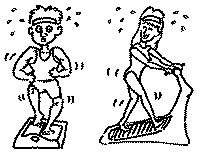|
||||||||||
 |
||||
|
Vol. 17, No. 27, January 3, 2005 |
||||
|
Last Call for Online Sign-up Not much time remains for members to sign-up for the meeting this Friday at Sammamish High School. Click on the icon of the red apple and textbooks on the right side of this page and follow the instructions. It’s simple! We need a head count for THIS WEEK The long holiday break (Wasn’t it wonderful?!) comes to an end this week as the Bellevue Breakfast Rotary Club greets a new calendar year and a momentous year in the history of this organization. Yes, our Centennial Year has arrived, with our birthday officially celebrated on February 23. District 5030 celebrates the event with a party at the Washington Convention and Trade Center on Thursday, February 3. This week, Glendale Country Club is closed for renovation. Our meeting has been moved to the cafeteria and auditorium of Sammamish High School, also newly renovated. Principal Spencer Welch will host our program at 7:00 a.m., Sammamish High School, corner of Main and 140th. Admin Corner New quarter has begun and this means a new billing period. Invoices to members have been mailed. Our attendance has hovered near 70% all year and club officers are dedicated to raising that back to a minimum 80%. If your attendance has been weak, you can easily improve your numbers by attending a make-up at another club (there’s plenty in the area find out when they meet here on the website). Members get credit for attending board meetings (next meeting at Hellam Veron, 1750 112th Avenue NE, Suite E200 on Tuesday, January 11, 2005), committee meetings of at least one hour duration held at places other than Glendale, New Member Experience each First Tuesday of the month at Jitters, District meetings, and hands-on projects sponsored by the club. No excuse for not carrying at least a 70% attendance record. C’mon gang, let’s build up our attendance percentage worthy of (one of) the best darned Rotary Clubs in the world! (A series of articles on exercise and health has been provided by Zone 23 Health Care Concerns Committee and sent along by PDG Rosemary Aragon) The WELLNESS SERIES Keep your joints a-jumping!
"There are a lot of things you can do to promote healthy joints," says orthopedic surgeon Charles Jung, MD, who practices at Group Health's Capitol Hill Campus in Seattle. "But the absolute worst thing you can do is sit around. Studies have shown that joint nourishment is entirely based on keeping joints in motion." The Leg Bone's Connected to the ... The secret to joint health begins with basic anatomy. Joints are the connecting points of at least two bones. Muscles move the bones. Ligaments cover the outside of bones and connect them. Tendons connect muscle to bone. Bursae, fluid-filled sacs, buffer everything inside the joint. Most important, joints are capped with cartilage — a fibrous connective tissue that provides shock absorption and supplies the frictionless quality of a normal, healthy joint. Synovial fluid nourishes the cartilage and makes it possible for bones to easily glide over each other. "Cartilage has no blood supply," explains P.Z. Pearce, MD, Spokane-area hospitalist and national sports medicine expert. "When you move your joints, the cartilage soaks up the synovial fluid inside the joint like a sponge." After age 35, synovial fluid becomes thinner and we produce less of it, says Dr. Pearce. Our cartilage production also slackens. "People in their 30s may notice that they are more prone to joint swelling after vigorous exercise," adds Chris Robinson, physical therapist at Eastside Hospital & Specialty Center in Redmond. "Their joints are actually traumatized by the impact, while a younger person's joints are more resilient. This is why the young bounce back more quickly from injuries." Common Ways to Blow a Joint Playing a sport or even momentary inattentiveness can result in a plant-and-twist injury — one of the most common joint injuries seen in Group Health medical centers. "I see plant-and-twist injuries all the time," says Jennifer Spence, MD, a personal physician at Factoria Medical Center. "You're just goofing around with your kids or friends — your foot stays in one place, but your torso turns 180 degrees. Suddenly, you're feeling it in your knee or ankle." When you injure your joints, you may notice pain, pressure, stiffness, limited motion, cracking, or, worst-case scenario — the joint simply gives way. Other common acute joint injuries include: • Torn cartilage • Dislocation — when a joint is forced out of alignment • Sprains — stretched or torn ligaments • Inflammatory conditions such as tendinitis or bursitis The answer to acute joint injuries is RICE: rest, ice, compression, elevation. Rest the afflicted joint. Ice two or three times each day for 15-20 minutes. Compress the injury by wearing a bandage or brace. Elevate it whenever possible. "When ligaments and muscles tear, the inevitable inflammation causes pain," says Dr. Spence. "Heat relaxes muscle spasms, but if you don't have spasms, ice takes a hit at inflammation." Inflammation is one of the body's protective responses to injury. You may not be able to describe the complex series of events that make up the inflammatory process, but you will notice the pain, heat, redness, and swelling. To ease some of these symptoms, your doctor may recommend using over-the-counter anti-inflammatories (such as Aleve or Advil) or a topical liniment made from an extract from hot peppers. Capsaicin works by initially stimulating and then, with repeated use, gradually dulling the pain signals in the body. The Greatest Threat to Joint Health Acute injuries aside, the primary cause of chronic joint pain and injury is stress from excess weight — from inertia or obesity. "Anyone who sits all day at work needs to get up and move for at least five minutes each hour," says Robinson. "A quick walk to the water cooler or some simple neck, shoulder, wrist, and back stretches will help alleviate stress on the joints." But walking to that water cooler can be problematic if you're not wearing sensible shoes. A 3-inch heel stresses your foot seven times more than a 1-inch heel. Make sure your shoe has enough room for toes to move around and is flexible at the ball of your foot, where you push off. Excess body weight, characterized as 10 percent over ideal body weight, can put more than four times the normal amount of stress on weight-bearing joints like the hips and knees. "We humans weren't designed to walk upright and have so much weight on our joints," says Dr. Spence. "This design flaw is exacerbated now that we're living longer. We've got 80- and 90-year-old patients who are quite athletic; some are ballroom dancers. People demand more from their joints." Putting on extra pounds when you're young exponentially increases pressure on the cartilage in weight-bearing joints — giving you less shock absorbency in later years. And don't assume that joint replacement surgery will be an easy fix for failed joints. "Joint replacement is major surgery requiring hospitalization and rehabilitation," says Dr. Spence. "I recommend it only when patients can't live another day with the pain." Dr. Jung, an orthopedic surgeon, and his Group Health colleagues perform 500-600 joint replacements on average each year at Eastside Hospital & Specialty Center in Redmond. The typical patient is 60-80 years old. Frequently, these patients did not maintain a healthy weight or improperly stressed their joints throughout their lifetime. "It's never too late to lose weight by getting involved in an exercise program," says Dr. Jung. "The average middle-aged person would go far in weight management by walking 3-5 miles a day or biking to work. If you're unaccustomed to exercise, try a stationary bike or start with low-impact or water aerobics." Exercise and Strength Conditioning The notion that exercise wears out your joints has gone the way of the tyrannosaur. Keeping your joints in motion will help you keep off excess weight — and strengthen muscles around the joints. "We don't see marathon runners having more joint injuries than sedentary folks," says Dr. Pearce. "Simply put, active people have less joint injury." To keep joints healthy you need to consistently put them through the full range of motion and do some kind of weight-bearing activity. Research also shows lifting weights creates denser bones and stable muscles, which is particularly important in people with a chronic condition such as osteoarthritis. The most prevalent form of the 100 types of arthritis, osteoarthritis is the result of deteriorated cartilage. Symptoms range from none to constant joint pain and swelling. "Osteoarthritis affects the daily activities of between 30 and 50 percent of all adults," says Dr. Pearce. "Research has shown that exercise is an essential tool in managing osteoarthritis. It's important, though, to understand your limits when exercising. If joint pain lasts more than a couple of days, you should definitely get it evaluated." If you have any physical limitations or chronic conditions, consult with your physician before beginning any exercise program. "Respect your level of fitness and listen to your body," says Dr. Spence. "Prepare for exercise by stretching." Stretch Your Joints and Give Yourself a Raise Most adults have woken up feeling as creaky as The Wizard of Oz tin man after a good hard rain. The proverbial oilcan for the muscles around human joints is stretching. "Yoga and tai chi are excellent stretching regimes," says Robinson. "But you have to pick a stretching program you like so that you'll stick to it. When you find a routine you enjoy, go slowly." Robinson cautions that muscle stretching isn't a cure-all for stiff joints. Before vigorous exercise, warm up your muscles for 5-15 minutes by walking and moving your arms. Keep well hydrated and rested by drinking water regularly — before you get thirsty — and getting 8-9 hours of sleep each night. As for stretching, she recommends that young people who participate in sports should be stretching for 15-20 minutes before and after practice, or they're setting themselves up for injury. Seniors also need to be particularly consistent with stretching to allow some play in the joints. "Walking, running, swimming, or any other exercise program doesn't automatically guarantee joint flexibility," says Robinson. "Incorporating flexibility and stretching prepares people — young or old — to participate in the activities of their choice." Posture Perfect When your mother told you to stand up straight, it wasn't just so you'd look presentable. Good posture keeps bones in alignment and prevents unnatural stress on muscles and joints. It also contributes to the healthy functioning of vital organs, especially in the abdomen. A healthy back is not stick straight. The back has three natural curves — at the neck, a slight backward curve at the upper back, and a slight forward curve in the lower back. Good posture is all about keeping those curves in balance and alignment. All you need is a full-length mirror to check your posture, as recommended by the American Physical Therapy Association. Good posture Front view: Head held straight, level shoulders, equal spaces between arms and sides of the body, kneecaps facing forward, straight ankles. Side view: Head held erect, chin parallel to the floor, shoulders in line with ears, chest held moderately elevated and the upper back erect, flat abdominal wall, lower back with a slight forward curve, straight knees. Poor posture Front view: Head tilted to one side, one shoulder lower than the other, unequal spaces between arms and sides of the body, one hip higher than the other, either or both knees turning in or out, weight supported by ankles that roll in. Side view: Head slumped forward, chin tilted up with head held back, shoulders drooped forward or pulled back, sunken in chest, upper back rounded, knees bent forward or locked. Physical therapists can evaluate your posture and suggest specific exercises to correct any problems you may have. Learn more from the American Physical Therapy Association at www.apta.org or call toll-free 1-800-999-2782. From Fall 2004 Group Health Cooperative of Puget Sound “Northwest Health Magazine”. www.ghc.org. THIS WEEK'S EDITOR
|
|||||||||||||
 |
|||||||||||||
 |
|||||||||||||
|
CLICK HERE |
|||||||||||||
|
Reveille | Reveille Archives | Meeting Information | Calendar | How to Join the BBRC | Officers & Directors | Committees | Online Member Directory | Short Directory PDF File | Directory Info Form | Set Up User Info | Forgot User Info | Meeting Make-Up Form | Attendance Statistics | New Member Application (PDF File) | Expense-Funding Request Form (PDF File) | Rotary Foundation Pledge Form | District 5030 Website & Newsletter | District 5030 Club Websites & Where-When They Meet | 2004 Raffle Winner | About the Raffle | Email Us
|
|||||||||||||


